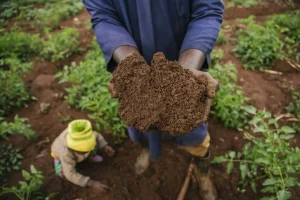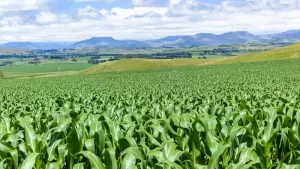
Black nightshade, locally known as managu, is a traditional African leafy vegetable widely grown across Kenya. black nightshade farming in Kenya is practiced in diverse agroecological zones, from highlands to lowlands, and is common in rural farms and peri-urban kitchen gardens. The crop is relatively fast-growing and can be harvested multiple times within a single season, making it a reliable source of income and nutrition for smallholder farmers.
Importance of Local Diets and Markets
Managu is rich in iron, calcium, and vitamins A and C, making it a vital component of many Kenyan households’ diets. It is often boiled and served with ugali or other staple foods. In addition to its nutritional value, black nightshade has become an increasingly marketable crop, especially in urban centers and open-air markets. The growing demand has created economic opportunities for small-scale farmers, particularly women and youth.
Challenges Faced by Farmers Due to Plant Diseases
Despite its resilience, black nightshade is highly vulnerable to various diseases. Fungal, bacterial, viral, and nematode infections can significantly reduce yields, lower produce quality, and lead to total crop failure if not adequately managed. Inadequate fertilizer use can further weaken plant health, making crops more susceptible to infections. Many farmers lack access to the proper knowledge, fertilisers, and tools.
Purpose of This Article
This article aims to educate Kenyan farmers about the 10 most common black nightshade diseases. It will help them identify disease symptoms early, understand how the infections spread, and learn practical management strategies. With this knowledge, farmers can protect their crops, improve yields, and sustain their livelihoods.
Fungal Diseases Affecting Black Nightshade in Kenya
Fungal infections are among the most common problems in managu farming, especially in warm and humid regions. Below are three key fungal diseases Kenyan farmers should watch out for:
1. Early Blight Black Nightshade Disease (Alternaria solani)
Symptoms
Early blight is a fungal disease caused by Alternaria solani. It typically presents as circular brown lesions with concentric rings, usually starting on older, lower leaves. As the disease progresses, the spots enlarge, and affected leaves turn yellow and drop prematurely.
Favorable Conditions
The disease thrives in warm, humid conditions, especially during the rainy season or in poorly ventilated areas. These conditions promote rapid fungal growth and spore spread.
Impact on Yield
Early blight significantly reduces photosynthesis due to premature leaf drop. This weakens plant vigor, slows development, and lowers yields, posing a significant risk to farmers depending on black nightshade for food or income.
Management Practices
Integrated disease management is key. Rotate crops with non-solanaceous plants like legumes to disrupt the fungal lifecycle. Apply fungicides such as mancozeb or chlorothalonil early in the season to contain the spread. Additionally, planting disease-resistant varieties provides a more sustainable way to manage early blight in the long term.
2. Powdery Mildew (Erysiphe spp.)
Symptoms
Powdery mildew appears as a white, powdery fungal growth on the upper surfaces of leaves.
Spread
The disease spreads through airborne spores, especially in dry conditions with high humidity at night.
Impact
It reduces the plant’s ability to photosynthesize, causing stunted growth and lower yields.
Control Measures
Apply sulfur-based fungicides or neem oil at the first signs of infection. Ensure good spacing between plants to improve air circulation. Remove weeds and crop debris that may harbor fungal spores.
3. Leaf Spot (Cercospora spp.)
Symptoms
Early signs include small, dark circular lesions, primarily on older leaves. Over time, these lesions may merge to form larger dead patches.
Impact
The disease leads to yellowing and defoliation, weakening the plant and reducing its overall productivity.
Management Strategies
Remove and destroy infected plant material to prevent the spread. Apply copper-based fungicides as a preventative measure. Avoid overhead watering to minimize leaf wetness, which favors disease development.
Bacterial Diseases Affecting Black Nightshade in Kenya
Bacterial infections can spread quickly through water, soil, or farming tools, often leading to severe crop damage. The following are two common bacterial diseases troubling black nightshade farmers in Kenya:
4. Bacterial Leaf Spot (Xanthomonas campestris)
Symptoms
Bacterial leaf spot appears as small, water-soaked spots on the leaves that enlarge over time and turn dark or necrotic. In some cases, a yellow halo may form around the infected areas.
Spread
The disease spreads mainly through splashing rain or irrigation water, contaminated tools, and handling of wet plants, which facilitates bacterial movement.
Impact
Bacterial leaf spot lowers leaf quality, weakens overall plant health, and can lead to significant yield losses if not managed promptly.
Control Measures
Avoid overhead irrigation to reduce water splash. Use certified, disease-free seeds to prevent introducing the bacteria. Disinfect tools regularly and practice crop rotation to minimize pathogen buildup in the soil.
5. Bacterial Wilt (Ralstonia solanacearum)
Symptoms
Bacterial wilt causes sudden wilting of healthy-looking plants, often without any prior yellowing. Cutting the stem may reveal brown discoloration in the vascular tissue, indicating internal infection.
Spread
The disease is transmitted through infected soil, water, and crop residues. The bacteria can survive in soil for several years, making it difficult to eliminate once established.
Impact
Bacterial wilt leads to rapid plant death and can result in total crop loss in severely infected fields.
Control Strategies
Avoid planting in fields with a known history of bacterial wilt. Improve soil drainage and prevent waterlogging to limit bacterial spread. Promptly remove and destroy infected plants—practice crop rotation with non-host crops such as maize or beans to break the disease cycle.
Viral Diseases Affecting Black Nightshade in Kenya
Viral infections are especially destructive in managu farming because they cannot be cured once plants are infected. These viruses are usually spread by insect vectors, making early prevention and pest control critical.
6. Tomato Yellow Leaf Curl Virus (TYLCV)
Symptoms
Viral infection causes young leaves to turn yellow and curl upward. Affected plants often appear stunted and bushy, with poor flowering and little fruit production.
Vector
The disease is primarily transmitted by whiteflies, especially Bemisia tabaci, which are common in warm climates.
Impact
The virus significantly reduces yield, particularly in regions where whiteflies are prevalent and challenging to control.
Control Measures
Use certified virus-free seedlings to prevent early infection. Install yellow sticky traps to monitor and reduce whitefly populations. Protect seedlings with insect-proof nets or fine mesh in nurseries. Apply recommended insecticides or use biological control methods to manage whitefly vectors effectively.
7. Cucumber Mosaic Virus (CMV)
Symptoms
Infected plants show light and dark green mosaic patterns on the leaves. Leaves may become distorted and narrow, and the plant often appears stunted. Flowering and fruit development may also be negatively affected.
Transmission
The virus is primarily spread by aphids in a non-persistent manner, meaning the insects can transmit it quickly after brief feeding.
Impact
The disease reduces plant vigor and lowers the marketability of the produce due to poor appearance and development.
Control Strategies
Remove and destroy infected plants immediately to prevent further spread. Use reflective mulches or silver plastic to repel aphids. Manage aphid populations with neem-based sprays or selective insecticides. Avoid planting near susceptible or infected crops such as cucumbers, peppers, or tomatoes.
Nematode and Soilborne Pathogens in Black Nightshade Farming
Soilborne pathogens and nematodes are invisible threats that attack plants from below the ground, often going unnoticed until significant damage has occurred. Proper soil health management is essential for preventing these issues in managu farming.
8. Root-Knot Nematodes (Meloidogyne spp.)
Symptoms
Root-knot nematode infestation causes swellings or galls on the roots. Above ground, affected plants show signs such as stunted growth, wilting, and yellowing, even when water is sufficient.
Spread
The pests spread through infested soil, contaminated planting materials, and crop residues left in the field.
Impact
Nematodes damage the roots, hindering water and nutrient uptake. This leads to weak plants and significantly reduced yields.
Control Measures
Practice soil solarization by covering moist soil with clear plastic during the hottest months to kill nematodes. Use resistant or tolerant varieties where available. Rotate crops with non-host plants such as cereals, and incorporate organic matter to enhance soil health and naturally suppress nematode populations.
9. Damping-Off (Pythium, Rhizoctonia spp.)
Affected Stage
Damping-off primarily affects seedlings, especially in nurseries or shortly after transplanting.
Symptoms
Infected seedlings show rotting at the base of the stem. Some may fail to emerge, while others collapse soon after sprouting.
Conditions
The disease thrives in poorly drained, waterlogged, or contaminated soils, particularly in humid environments.
Control Strategies
Use sterile soil or seed-starting media in nurseries to prevent contamination. Ensure good drainage and avoid overwatering. Apply appropriate fungicide seed treatments before sowing, and thin seedlings to improve air circulation and reduce humidity around plants.
Mixed and Secondary Infections
Some diseases, like anthracnose, often occur alongside or after other infections, especially in moist, poorly managed fields. These secondary pathogens can rapidly reduce the quality of black nightshade produce if not adequately controlled.
10. Anthracnose (Colletotrichum spp.)
Symptoms
Anthracnose causes sunken, dark lesions on stems, leaves, and fruits. These lesions may develop pinkish spore masses at the center during wet conditions. Infected fruits can rot prematurely, reducing their marketability.
Favorable Conditions
The disease thrives in warm, humid environments with frequent rainfall or overhead irrigation, which promote spore germination and spread.
Impact
Anthracnose weakens plant structure and can lead to significant post-harvest losses due to fruit rot and reduced quality.
Control Measures
Remove and destroy infected plant debris after harvest to reduce inoculum. Apply copper-based fungicides preventatively, especially during wet periods—practice crop rotation with non-host crops to break the disease cycle. Maintain good field hygiene and avoid working in wet fields to prevent spores from spreading.
Conclusion
Black nightshade (managu) remains an essential crop for food and income in many parts of Kenya. However, its production is increasingly threatened by various fungal, bacterial, viral, and soilborne diseases. This article has highlighted 10 major diseases affecting managu farms, their symptoms, causes, and practical control measures that farmers can adopt.
Early detection is critical to managing these diseases effectively. Farmers are encouraged to practice Integrated Pest Management (IPM), which combines cultural, biological, and chemical methods to control diseases while preserving soil health.
Regular field scouting, maintaining clean planting practices, using certified seeds, applying the fertiliser, and observing proper crop rotation are good agronomic habits that contribute to healthy crops and higher yields.
Additionally, adopting organic pest control for managu, such as using neem-based sprays or intercropping with pest-repelling plants, can help reduce chemical use while maintaining plant health. For more detailed information, visit the University of California’s Integrated Pest Management guide.
Finally, farmers should consult local agricultural officers or extension workers for personalized advice and support. Timely expert guidance can distinguish between a successful harvest and a failed crop.




